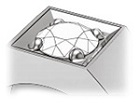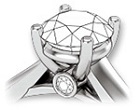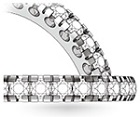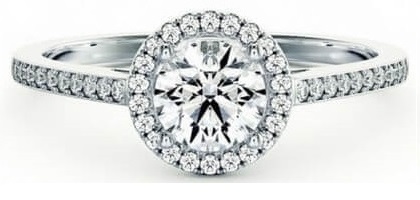Setting type refers to the metal base that holds a stone in place. Each setting style is created to enhance both the beauty of the stones and the appearance of a jewellery piece. The descriptions below will help you select the perfect setting type for your needs.
An engagement ring should be a reflection of the person wearing it. Here are a few tips to help begin: A woman with simpler, more streamlined taste may prefer a beautifully-made solitaire setting with one fantastic diamond. For women who like a lot of sparkle, an intricate pave setting with rows of diamonds might be preferable. A vintage setting with delicate engraving might appeal to a woman who has a penchant for the classics. Beautiful baguette side stones give a more contemporary feel to a ring, and gemstone settings are great for a woman who loves color. Tension settings will likely appeal to a more modern woman.
Consider the woman, and the right style will become clear. Remember that the wedding band that will follow will need to match the engagement ring in terms of style and metal. The width of the ring is also a factor, since it will soon have a wedding ring next to it. A woman with small hands will want a narrower band on her rings, while a woman with larger hands might prefer a wider band.

Prong setting.
The prong setting is one of the most popular setting types. The setting has small metal prongs that are bent over the girdle of the gemstone or diamond. Many prefer this setting type for their engagement ring, stud earrings or tennis bracelet, as it allows for the greatest exposure of the diamond and minimizes the appearance of the metal. This highlights the diamonds and will also allow more light to pass through, which affects the brilliance of the jewellery.

Channel setting.
A channel setting refers to a type of stone setting often used in mounting a number of small stones of uniform size in a row. Instead an individual set of prongs holding each stone, the stones are fitted into a channel and held into place on each side by a continuous strip of metal. This is a popular setting type for diamond rings and tennis bracelets.

Bezel setting.
A bezel setting is used when a diamond is completely surrounded by metal. Primarily known for its clean appearance and sturdiness, this setting style encases the outer edge of the diamond in a fine frame of metal. When set in platinum or white gold, it can make the diamonds appear larger. The bezel setting is often used with round shaped diamonds, but also works well with other diamond shapes.

Half-Bezel setting.
A semi-bezel setting, or half-bezel setting, is when the diamond is only partially surrounded by the metal setting. This setting type is popular with diamond bands and tennis bracelets.

Pave setting.
The pave setting allows light to reflect off the many facets of a diamond. It uses numerous small diamonds set with tiny prongs to create a continuous surface of radiance and shimmer. This setting type is preferred for engagement rings and earrings.

Common shared prong setting.
A common shared prong setting is a variation of the traditional prong setting in which the prongs are wrapped around the crown of more than one stone. This type of setting minimizes the appearance and presence of metal and allows additional light to pass through a diamond or gemstone.

Tension setting.
A tension setting refers to a diamond ring setting where the diamond is held in place by pressure rather than with prongs. The gold or platinum setting is actually spring-loaded to exert pressure onto the diamond, and tiny etchings or grooves are added to the gold or platinum in order to create a shelf structure for the diamond's edges to rest. The diamond appears to 'float' or be suspended in the air with nothing holding it in place. It is a secure setting type for a diamond engagement ring or wedding ring.

Bright - cut setting.
A bright-cut is a metal engraving technique which involves chiseling the metal with a polished tool. The result is a highly reflective surface.

Bridge accent setting.
A bridge accent is a design element located beneath the center stone than can be seen when looking at the ring in the through-finger view.

Illusion setting.
An illusion is a setting technique patented by Van Cleef & Arpels in 1933. A diamond is placed in a collet of reflective, highly polished metal so that it appears to be part of the gemstone. This enhances the perceived size of the diamond.

Gypsy/Flush setting.
A gypsy/flush is a setting technique in which the gemstone is embedded within the band. The metal from the band is used to secure the gemstone, leaving only the top of the gem visible.

Fishtail setting.
A fishtail is a beautiful setting technique consisting of four prominent triangular corners cut from the existing shank that hold the gemstone in place. When viewed from the finger-view it looks like the tail of a fish.

Scallop setting.
A scallop is a gemstone-setting technique in which the prongs are created from the shank. A fishtail is one example of a scalloped setting.

Trellis setting.
A trellis is a structure of open latticework. It is especially used as a gallery support for gemstones.

Bar setting.
A bar is a setting technique in which the gemstone is secured between two parallel bars while the sides of the gem remain open.

Twist setting.
Twist settings are becoming more and more popular among couples looking to buy an engagement ring. In this setting, the metal band is shaped and turned to create a crisscrossed effect. The result is a unique look that is as complex as it is delicate.
Pave (pronounced pa-vey) is a type of stone setting that describes many small stones set closely together in a piece of jewellery. Pave setting is very common in engagement rings and is a great way to add extra sparkle to a piece while staying in budget. Let's take a look at everything you need to know when looking for a pave ring to make a smart purchase.
The word pave has French origins and means "paved", as the surface of a piece with this setting looks like it has been paved with stones. In modern pave settings, the diamonds that make up the pave are separated and held in place by little metal beads. These beads are either shaped from the existing metal in the setting or are soldered on. Because these beads are so tiny and surrounded by many small diamonds, they seem to disappear into the background, resulting in what looks like a continuous surface of shine.
Rings often feature pave along the shank, in a halo, or even on the prongs in which the centerstone is set. Wedding bands also commonly have pave set diamonds.
Rings with pave along the shank generally only feature stones halfway around the band to allow for adjustment of ring size. If pave set diamonds span all the way around the band, most of the ring will have to be dismantled to resize it, what can cause major issues in the future.



Selection of pave rings.
CTTW, or total carat weight, refers to the sum total weight of all diamonds set in a jewellery item. To calculate the total carat weight, simply add together the carat weight of all the diamonds in that given piece. When it comes to pave set rings, the CTTW may refer to the total carat weight of the entire ring including the centerstone or just the total carat weight of the pave set stones, depending on the context.
Although pave diamonds may seem very small, when there are many set together, their CTTW can add up. Keep in mind that pave ring prices will go up as their CTTW increases. Setting pave diamonds is quite labor intensive, but even with the added cost of this work, pave tends to cost less than larger sidestones and provides a particular shine that larger stones don't quite deliver.
While the pave is designed to add to the overall brilliance of a jewellery piece, there are several different types of pave settings used.

Pave setting types.
The micro pave setting features extremely small diamonds, each stone weighing less than 0.01 carats. These gems are so small that it looks like the entire piece is made of diamonds or other gemstones.
A typical micro pave setting may contain several rows of gemstones to cover the entire piece. This style is one of the most delicate and beautiful varieties of the pave setting with stunning sparkle and detail. However, the micro pave is also among the most expensive because of the work required to create it.
The u-cut pave setting is one of the most popular styles today.
The name of this setting type comes from the shape of the grooves into which the stones are set. From the side view, these grooves resemble the letter U.
This pave style is designed to reduce the amount of metal and increase diamond visibility and sparkle, allowing light to enter from sides.
The scalloped pave setting is another popular style that immediately catches attention. The name of this pave setting type comes from the shape of the metal beads with U-shaped cut-outs, which create a scalloped look. Like the U-cut pave, scalloped pave is designed to reduce the amount of metal used and to accentuate the gemstones' sparkle.
The french pave offers a unique look to any piece of jewellery due to the combination of engraving work and diamond setting style.
French pave, also known as fishtail pave, incorporates a V-shaped groove underneath each gemstone. This allows more light to hit the stone and minimize the amount of metal used. Like the U-cut pave, this style enhances gemstones' sparkle and visibility.
Petite pave is similar to traditional pave setting, except that it uses much smaller prongs to hold the gemstones in place, which allow pave stones to be more visible.
The petite pave setting is often confused with the micro pave, although they are quite different. The idea of the petite pave is to focus on tiny prongs, while the micro pave setting focuses on the gemstones.
The bright cut pave, also referred to as channel pave, is one of the oldest types of pave setting. This style features gemstone melees hold between two metal walls with tiny prongs to keep them in position.
One of the main benefits of this pave style is that the walls provide additional durability to the gems, keeping them safe from accidental hits. However, compared to other pave styles, the bright cut pave reduces gemstone sparkle and maximizes metal use.
The main difference between micro pave and pave is that the stones used in micro pave are smaller and are set using a different technique. Unlike regular pave, where stone sizes can vary in order to fill the space, micro pave uses stones of a uniform size that are offset from row to row, creating a honeycomb-like pattern.
Diamonds used for a standard pave setting must be 0.01 to 0.02 carat - anything smaller than that is considered micro pave.
Micro Pave

Pave

Pave setting vs. micro pave setting.
In general, pave is an extremely flexible setting type that works beautifully with modern and vintage-style designs:
Pave set diamonds give tons of sparkle to a ring and create a true "wow" factor, personality and elegance but also has an affordable price tag.
The main benefit of pave setting jewellery is creating the illusion of the gems being more plentiful and bigger. This setting also highlights the centre stone and make it look bigger due to the additional sparkle, for example, pave in a halo setting.
Since the individual stones in the setting are very small and less visible, they often have a single cut, i.e. only 16, 17 or 18 facets. That is the main reason why gems are quite affordable in price. As opposed to larger sidestones, pave set diamonds are less costly and provide just as much shine.
As a general rule, the pave setting does not need much special care. The stones are held pretty tight together by tiny metal beads or prongs, and these are very safe as long as they are not worn out or broken.
Because pave set diamonds are so small, they tend to fall out with rough use. You should try to avoid hitting or damaging your jewellery as much as possible because there is still a low chance of losing the pave stones.
CTTW of pave rings may be misleading, as it includes many tiny stones.
So now that you know a bit more about pave, let's look at some tips you need to know before buying:
Pay attention to the distribution of the pave diamonds. Many times, jewellers will add pave diamonds to obscure sections of a ring in order to increase the price of the ring. Pave set diamonds far down the band that are hidden by fingers, for example, may not be worth paying extra for.
As the diamonds used in pave are quite small, it is difficult to notice any imperfections with the naked eye. Examine the pave under a microscope to make sure that none of the diamonds are chipped or damaged in any way.
Similarly, check the surface of the pave diamonds to make sure that they are smooth and even.
Pave, a type of stone setting that describes many small stones set closely together, is a very common element in engagement rings that offers major sparkle. Originating from the French word for "paved", pave setting is often found on the shank or halo of a ring. Despite their beauty, pave diamonds do have a tendency to fall out with wear and tear. Make sure to examine your pave ring closely for quality of work before purchasing.
Did you know that the setting metal you choose can make the color of your diamond look better or worse? The choice of metal can affect the ring's style and appearance as well as make the stone appear whiter or tinted. Let's find out how to choose the best setting for your diamond based on its color to achieve the look you want.

Diamond color.
When talking about diamond color, we mean how colorless the stone is. The highest quality diamonds are completely colorless, while lower quality diamonds have yellowish or brownish tints.
Diamond color is graded using a scale developed by the GIA. which goes from D to Z, with D being the most colorless and Z containing yellow or brown tints noticeable to the naked eye.
Each letter grade falls under a clearly defined range of color appearance:
D-E- F: Colorless.
G-H-I-J: Near Colorless.
K-L-M: Faint Color.
N-R: Very Light Color.
S-Z: Light Color.
Diamond color grade is one of the factors that significantly affect diamond prices which is why this aspect should never be overlooked. Choosing the right color for your setting could help you save some money without affecting the look of your jewellery and overpaying for a feature that would remain unnoticed.
Polished diamonds are highly reflective, meaning the color of the metal you choose will be reflected within the stone. If you have a diamond with yellowish or brownish tints (K grade or lower), it is not a good idea to have it set in a white metal such as platinum or white gold. As a result of the increased contrast, the stone's coloration will be more noticeable. That is why putting such a diamond in white metal will only make the stone look even more tinted.
Instead of going for a white setting, it is recommended to opt for a colored metal such as yellow or rose gold. The metal's color will mask the yellowish tints of the stone and make it look whiter against the mounting.
When choosing a setting for a tinted diamond, it is important to make sure the prongs are of the same color as the rest of the setting. In case the mounting is made of colored metal and the prongs holding the stone are white, they will still enhance the yellow tints in your diamond.
The most suitable setting for a near colorless diamond will depend on where in the range your stone falls. If your diamond is graded G or H, then the stone will barely have any tints and it is safe to have your diamond set in white gold or platinum.
If your diamond is graded I or J, it will have a bit stronger yellow tint, so it is better to opt for colored metals. However, there is an exception to every rule. Round and princess cut diamonds tend to hide color imperfections in the diamond rough, meaning it is still safe to have them set in white metals. For other cuts. you should consider a yellow or rose gold setting.
Keep in mind that the visibility of yellow tints in a diamond also depends on its cut quality. An ideal cut stone may reflect light in a way that would make any tints nearly invisible, while a poor cut makes the coloration even more noticeable.
If your diamond falls within the colorless range (D-E-F), you have a larger choice of settings, colored metals work fine with colorless diamonds as they still stand out when mounted in them. However, it worth mentioning that such a setting will add some yellow tint to the stone.
In case you do not want to add more color to the diamond, you better have it set in white gold or platinum. If you still prefer colored metals, it makes sense to use white metals for your prongs. This will help to make the centre stone look whiter against a colored background. After all, if you have paid so much money for a colorless diamond, it is worth making sure its color will not be tinted in any way.
There is also another reason to opt for the white metal and it has to do with durability. Platinum lasts longer than gold, ensuring your prongs will wear down very slowly. As a result, you will not need to get your ring fixed that often.